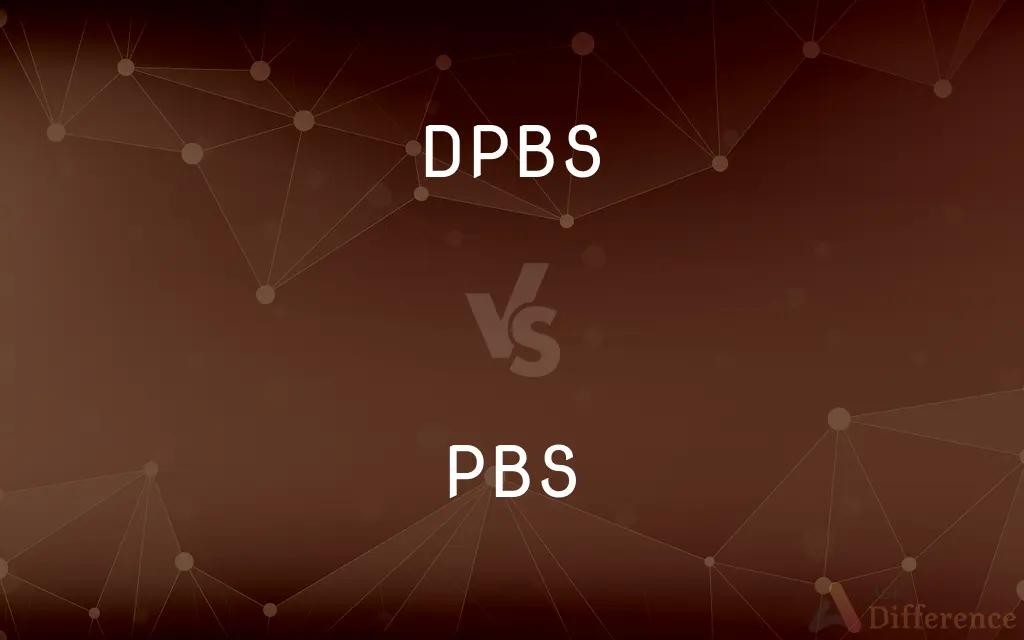DPBS vs. PBS — What's the Difference?
By Tayyaba Rehman & Fiza Rafique — Published on March 7, 2024
DPBS and PBS are both buffer solutions used in biological research to maintain pH and osmolarity of samples. DPBS is a modified version of PBS that contains additional components like calcium and magnesium, making it suitable for certain cell culture.

Difference Between DPBS and PBS
Table of Contents
ADVERTISEMENT
Key Differences
DPBS and PBS serve as isotonic buffering solutions widely used in cell culture and molecular biology to provide a stable pH environment for cells and biological samples. The primary function of both is to maintain tissue samples and cells at a physiological pH during experimental manipulations, such as washing cells in tissue culture procedures.
The main difference between the two lies in their composition. PBS is a basic salt solution that typically does not contain calcium and magnesium. Its simplicity makes it suitable for a variety of applications, including immunoassay washes and as a diluent for preparing solutions. DPBS, on the other hand, is a variation of PBS that is often supplemented with calcium and magnesium to support cell attachment to culture vessels, making it particularly useful in tissue culture applications where the presence of these ions can be crucial for cell adhesion and signaling.
Another key difference is in their specific applications. While both can be used for washing cells, DPBS's additional components make it more suitable for supporting environments that closely mimic physiological conditions, which is essential for certain types of cell culture experiments. In contrast, PBS's lack of calcium and magnesium can make it preferable for experiments where these ions might interfere with molecular interactions, such as in some biochemical assays or when using EDTA to chelate magnesium-dependent enzymes.
Despite these differences, both DPBS and PBS are essential tools in biological research, offering researchers flexibility in maintaining the physiological conditions necessary for a wide range of experiments. The choice between DPBS and PBS ultimately depends on the specific requirements of the experiment and the sensitivity of the cells or biological samples to calcium and magnesium ions.
Comparison Chart
Composition
Contains calcium and magnesium
Does not contain calcium and magnesium
ADVERTISEMENT
Applications
Cell culture, where cell adhesion is necessary
General laboratory use, including immunoassays
Ion Concentration
Higher, due to additional cations
Lower, lacks additional cations
Suitability
Supports environments mimicking physiological conditions
Suitable for a wide range of biological research
Cell Adhesion
Promotes cell adhesion to culture vessels
Less supportive of cell adhesion without supplementation
Compare with Definitions
DPBS
It mimics physiological conditions, making it ideal for tissue culture applications.
DPBS maintained the cells in a condition close to their natural environment during the experiment.
PBS
PBS is a simple buffer solution used to maintain pH in a range of biological applications.
PBS was used for diluting antibodies in an immunoassay.
DPBS
Suitable for applications where ion presence is crucial.
DPBS was chosen for its complete formulation, which supported cell growth in culture.
PBS
Lacks calcium and magnesium, making it versatile for many laboratory uses.
The absence of calcium in PBS prevented unwanted cell adhesion during washing steps.
DPBS
Promotes the survival and growth of cultured cells.
Cultured neurons thrived in DPBS due to its optimized ionic composition.
PBS
Commonly used as a wash solution in molecular biology protocols.
PBS was used to rinse cells before applying a fluorescent stain.
DPBS
DPBS is a phosphate-buffered saline solution enhanced with calcium and magnesium, supporting cell adhesion.
DPBS was used to wash adherent cells without detaching them from the culture dish.
PBS
A standard solution for preparing and diluting samples in research.
The researcher prepared a sample dilution in PBS for a spectrophotometric analysis.
DPBS
Often used in cell-based assays requiring calcium and magnesium.
The presence of calcium in DPBS facilitated cell signaling studies.
PBS
Suitable for experiments where the absence of additional ions is required.
PBS was chosen to avoid interference in a magnesium-sensitive enzymatic reaction.
PBS
Phosphate-buffered saline, a normal saline solution containing a phosphate buffer.
PBS
Public Broadcasting System; a system of non-profit radio and television broadcasting stations.
PBS
A solution containing a phosphate buffer
Common Curiosities
Why choose DPBS over PBS?
Choose DPBS when your cell culture work requires calcium and magnesium to support cell adhesion and signaling.
Can the absence of calcium and magnesium in PBS affect cell experiments?
Yes, in experiments where cell adhesion or signaling is critical, the absence of these ions in PBS could negatively impact cell behavior.
Is DPBS interchangeable with PBS in immunoassays?
It depends on the assay's sensitivity to calcium and magnesium; DPBS might interfere in assays where these ions are not desired.
Why does PBS not contain calcium and magnesium?
PBS is designed to be a simple, versatile buffer; the absence of these ions prevents complications in experiments where they might interfere.
Can I add calcium and magnesium to PBS to make it similar to DPBS?
Yes, calcium and magnesium can be added to PBS, but the solution should be sterile filtered to ensure it is suitable for cell culture applications.
Can PBS be used instead of DPBS in cell culture?
PBS can be used for washing cells in cultures where calcium and magnesium are not required, but it may not support cell adhesion as well as DPBS.
Are there any risks in using DPBS in place of PBS?
The main risk is the potential for calcium and magnesium in DPBS to interfere with experimental parameters where these ions are not desired.
How do calcium and magnesium support cell culture in DPBS?
These ions play critical roles in cell adhesion to culture vessels and are involved in many signaling pathways, supporting cell health and function.
What precautions should be taken when switching from PBS to DPBS in protocols?
Consider the impact of calcium and magnesium on your experiment, and ensure that these ions do not interfere with your assay or cell culture conditions.
Is DPBS more expensive than PBS?
The price can vary, but DPBS may be slightly more expensive due to its additional components; however, the cost difference is generally minimal in the context of overall laboratory expenses.
Share Your Discovery

Previous Comparison
Nachos Chips vs. Tortilla Chips
Next Comparison
Induction Motor vs. Synchronous MotorAuthor Spotlight
Written by
Tayyaba RehmanTayyaba Rehman is a distinguished writer, currently serving as a primary contributor to askdifference.com. As a researcher in semantics and etymology, Tayyaba's passion for the complexity of languages and their distinctions has found a perfect home on the platform. Tayyaba delves into the intricacies of language, distinguishing between commonly confused words and phrases, thereby providing clarity for readers worldwide.
Co-written by
Fiza RafiqueFiza Rafique is a skilled content writer at AskDifference.com, where she meticulously refines and enhances written pieces. Drawing from her vast editorial expertise, Fiza ensures clarity, accuracy, and precision in every article. Passionate about language, she continually seeks to elevate the quality of content for readers worldwide.













































